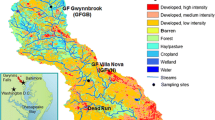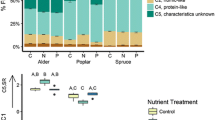Abstract
Headwater streams are in close contact with the landscape and known to mediate disturbances to downstream waterways through important ecological interactions. We studied how elevated chloride from road deicer, a pollutant of rising concern in urban ecosystems, influenced the leaf-microbial matrix in streams, and subsequent processing of C and N. In a multi-factorial laboratory experiment, we determined if elevated chloride interacts with nitrogen loading and invertebrate consumer feeding to alter rates of leaf litter breakdown and N immobilization. Naturally colonized leaf litter, the dominant C source in small streams, was collected from five Piedmont streams (Maryland, USA) and subjected to a gradient of NaCl (0, 1,000, 5,000 mg Cl l−1) and dissolved nitrogen (ambient, elevated), and an invertebrate treatment (presence, absence) in a total of 60 microcosms. Loss rate and C:N content were determined from remaining leaf litter after 16 d of incubation. Chloride loading significantly (P < 0.05) reduced loss rate regardless of N loading, and C:N content significantly (P < 0.05) increased with Cl concentration, interacting marginally (P < 0.10) with N loading. Invertebrate feeding had a marginally-significant (P < 0.10), negative effect on loss rate, but not C:N content. Overall, elevated chloride significantly influenced organic matter loss rate and N immobilization, despite N loading and the presence of invertebrates. We conclude that there is the potential for chloride loading as road deicer runoff to negatively influence microbial processing of C and N by stream-dwelling microbial communities.


Similar content being viewed by others
References
Alexander RB, Smith RA, Schwarz GE (2000) Effect of stream channel size on the delivery of nitrogen to the Gulf of Mexico. Nature 403:758–761
Bärlocher F (1982) Conidium production from leaves and needles in four streams. Can J Bot 60:1487–1494
Cross WF, Wallace JB, Rosemond AD, Eggert SL (2006) Whole-system nutrient enrichment increases secondary production in a detritus-based ecosystem. Ecology 87:1556–1565
Elshahed MS, Najar FZ, Roe BA, Oren A, Dewers TA, Krumholz LR (2004) Survey of archael diversity reveals an abundance of halophilic Archaea in a low-salt, sulfide- and sulfur-rich spring. Appl Environ Microbiol 70:2230–2239
Environment Canada (2001) Assessment report—road salts
Fisher SG, Likens GE (1973) Energy flow in Bear Brook, NH: an integrative approach to stream ecosystem metabolism. Ecol Monogr 43:412–439
Greenwood JL, Rosemond AD, Wallace JB, Cross WF, Weyers HS (2007) Nutrients stimulate leaf breakdown rates and detritivore biomass: bottom-up effects via heterotrophic pathways. Oecologia 151:637–649
Groffman PM, Dorsey AM, Mayer PM (2005) Nitrogen processing within geomorphic features in urban streams. J N Am Benthol Soc 24:613–625
Gulis V, Rosemond AD, Suberkropp K, Weyers HS, Benstead JP (2004) Effects of nutrient enrichment on the decomposition of wood and associated microbial activity in streams. Freshw Biol 49:1437–1447
Hale RL, Groffman PM (2006) Chloride effects on nitrogen dynamics in forested and suburban stream debris dams. J Environ Qual 35:2425–2432
Hall RO, Likens GE, Malcom HM (2001) Trophic basis of invertebrate production in 2 streams at the Hubbard Brook Experimental Forest. J N Am Benthol Soc 20:432–447
Heiber M, Gessner MO (2002) Contribution of stream detrivores, fungi, and bacteria to leaf breakdown based on biomass estimates. Ecology 83:1026–1038
Herlihy AT, Stoddard JL, Johnson CB (1998) The relationship between stream chemistry and watershed land cover data in the Mid-Atlantic Region, U.S. Water Air Soil Poll 105:377–386
Horton RE (1945) Erosional development of streams and their drainage basins: hydrophysical approach to quantitative morphology. Geol Soc Am Bull 56:275–370
Johnson BR, Wallace JB, Rosemond AD, Cross WF (2006) Larval salamander growth responds to enrichment of a nutrient poor headwater stream. Hydrobiologia 573:227–232
Kaushal SS, Groffman PE, Likens GE, Belt KT, Stack WP, Kelly VR, Band LE, Fisher GT (2005) Increased salinization of fresh water in the northeastern U.S. Proc Natl Acad Sci 102:13517–13520
Kaushal SS, Pace ML, Groffman PM, Band LE, Belt KT, Mayer PM, Welty C (2010) Land use and climate variability amplify contaminant pulses. Eos 91:221–222
Littell RC, Milliken GA, Stroup WW, Wolfinger RD (1996) Heterogeneous variance models. Chapter 8 in SAS system for linear models. SAS Institute Incorporated, Cary
Morgan RP II, Kline KM, Cushman SF (2007) Relationships among nutrients, chloride and biological indices in urban Maryland streams. Urban Ecosyst 10:153–166
Ostrofsky ML (1993) Effect of tannins on leaf processing and conditioning rates in aquatic ecosystems: an empirical approach. Can J Fish Aquat Sci 50:1176–1180
Ostrofsky ML (1997) Relationship between chemical characteristics of autumn-shed leaves and aquatic processing rates. J N Am Benthol Soc 16:750–759
Petersen RC, Cummins KW (1974) Leaf processing in a woodland stream. Freshw Biol 4:343–368
Peterson BJ, Wollheim WM, Mulholland PJ et al (2001) Control of nitrogen export from watersheds by headwater streams. Science 292:86–90
Relyea RA, Hoverman JT (2008) Interactive effects of predators and pesticides on aquatic communities. Oikos 117:1647–1658
Ribblett SG, Palmer MA, Coats DW (2005) The importance of bacterivorous protists in the decomposition of stream leaf litter. Freshw Biol 50:516–526
Sponseller RA, Benfield EF (2001) Influences of land use on leaf breakdown in Southern Appalachian headwater streams: a multiple-scale analysis. J N Am Benthol Soc 20:44–59
Wallace JB, Webster JR, Cuffney TF (1982) Stream detritus dynamics: regulation by invertebrate consumers. Oecologia 53:197–200
Wallace JB, Eggert SB, Meyer JL, Webster JR (1997) Multiple trophic levels of a forest stream linked to terrestrial litter inputs. Science 277:102–104
Webster JR, Benfield EF (1986) Vascular plant breakdown in freshwater ecosystems. Annu Rev Ecol Syst 17:567–594
Zumft WG (1999) The denitrifying prokaryotes. In: Dworkin M, et al. (eds) The prokaryotes: an evolving electronic resource for the microbiological community, 3rd ed. Release 3.0. Springer-Verlag, New York, NY. Available at http://141.150.157.117:8080/prokPUB/index.htm (verified 9 Aug. 2006)
Acknowledgements
We gratefully acknowledge support from the US National Science Foundation (NSF), Long- Term Ecological Research the program (DEB-0423476), and from the Power Plant Research Program of the Maryland Department of Natural Resources through its Biology Integrator contract (KOOB5200176) with Versar, Inc., and the US Geological Survey (Project # 2008MD171B). The opinions and findings expressed in this paper are those of the authors and not of the National Science Foundation.
Author information
Authors and Affiliations
Corresponding author
Rights and permissions
About this article
Cite this article
Swan, C.M., DePalma, C.A. Elevated chloride and consumer presence independently influence processing of stream detritus. Urban Ecosyst 15, 625–635 (2012). https://doi.org/10.1007/s11252-011-0210-7
Published:
Issue Date:
DOI: https://doi.org/10.1007/s11252-011-0210-7




